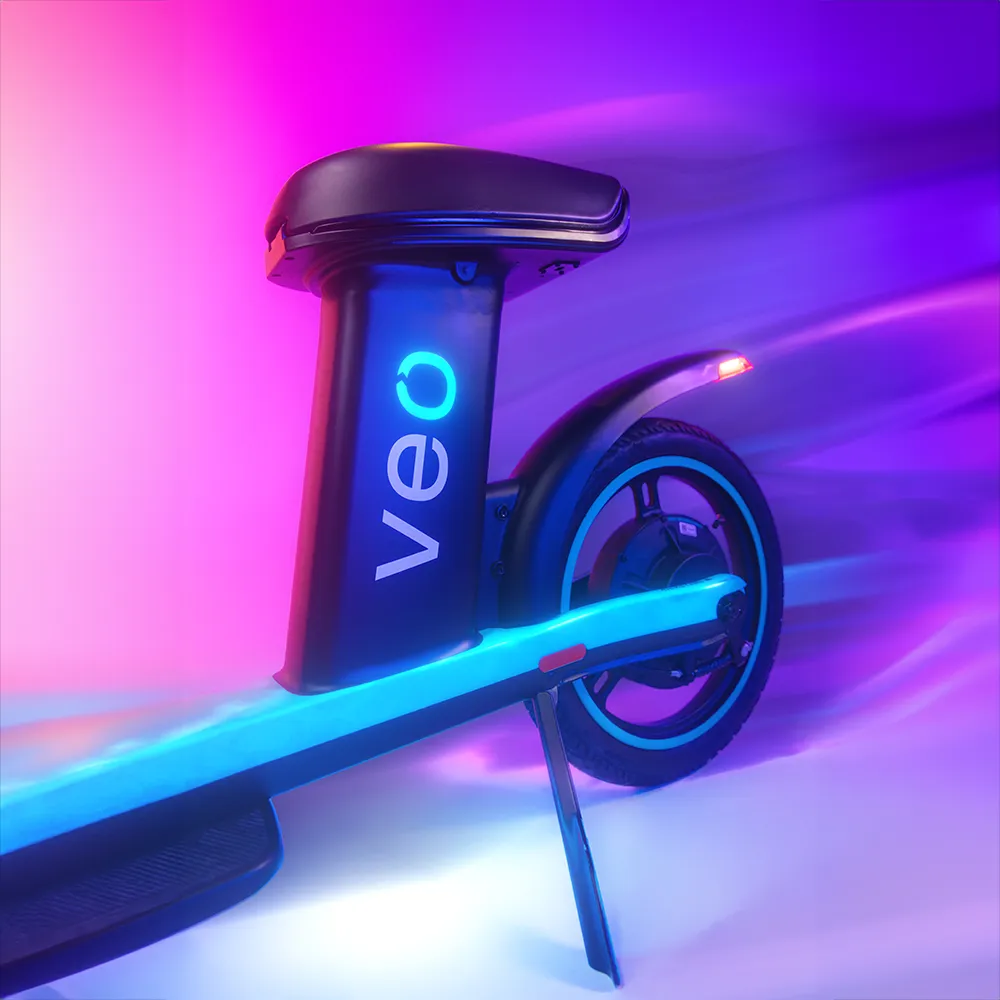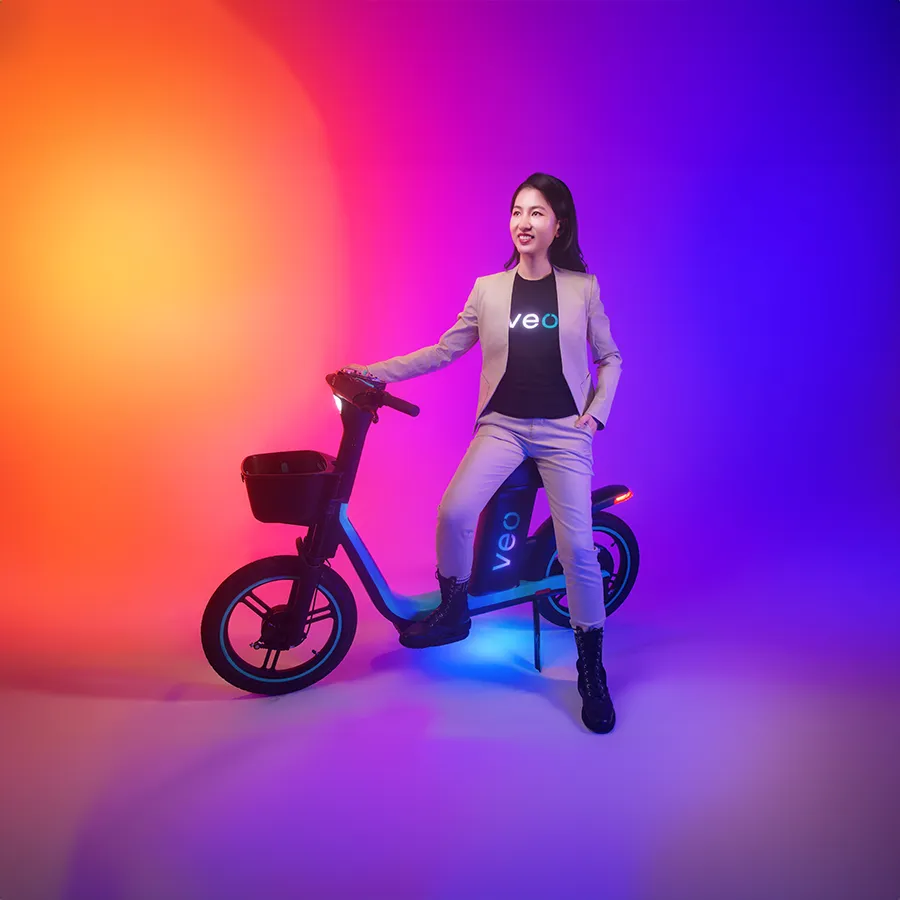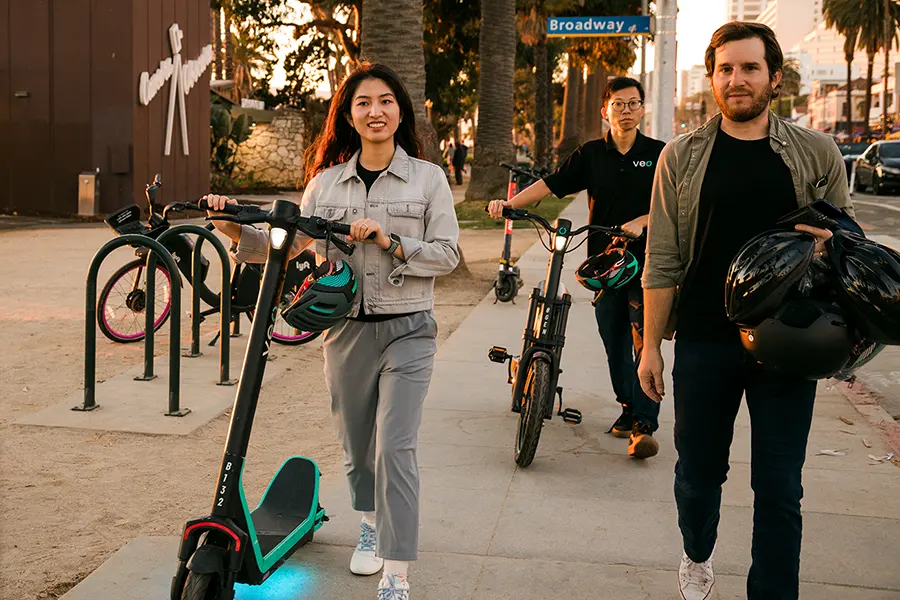
When Daniels School alumna Candice Xie (BSF ’16) cofounded Veo, she wasn’t just setting out to launch another startup. She was building something with roots — roots that trace back to Purdue, where she and cofounder Edwin Tan first began to imagine a better way to move through cities. What started as an idea between classmates evolved into one of North America’s largest shared micromobility companies — profitable, sustainable and focused on the long game.
The company’s goal of providing affordable, environmentally friendly transportation in and around universities with dense student populations and strong bike access made Purdue the perfect choice for a pilot program. Following two months of testing, Veo made its official debut in October 2017 when Xie and Tan placed 160 of their distinctive teal-colored bikes around the West Lafayette campus and made a phone app available for download.
“I remember a photo shoot we did in front of the Union,” Xie says. “That was when we had just launched. We’d already graduated and worked for a year before starting Veo, but we decided to come back to West Lafayette because of the strong community and support at Purdue. It just felt like the right place to begin.”
Xie says the Purdue Foundry played a key role in the company’s early growth. “They were tremendously helpful. We met a lot of experienced entrepreneurs, made great connections and even hired some of our first employees through their network. They also helped us develop our business plan and get our first angel and institutional investors,” she says.
For Xie, entrepreneurship wasn’t always the plan. With a finance degree and experience in a rotational program at Schneider Electric, her career seemed set. But working with the Foundry opened her eyes. “We were consulting for a biotech startup. That firsthand exposure — helping them with financial modeling, understanding their challenges — that’s what sparked my interest.”
Still, launching Veo was no easy ride.
“Our biggest challenge at the start was credibility,” Xie says. “We were just two young people with no track record. At our first trade show in San Antonio, it was just Edwin and me. I made myself a ‘business development manager’ and Edwin put ‘engineering intern’ on his business card, just to seem more legit. We even hired someone to hand out flyers so we looked bigger than we were.”

As a female founder, especially in a male-dominated industry like transportation, Xie faced a different set of challenges.
“I got all the unfavorable labels: I’m a woman, I’m an immigrant and I’m a first-time founder. There’s unconscious bias,” she says. “When I pitched investors, they’d often ask about risk — whether I’d stick with the business if my significant other didn’t support me. I don’t think male founders get those questions.”
Resource constraints were also real. “When we launched our program at a college in New Hampshire, it was still snowing,” Xie says. “We rented a U-Haul, loaded bikes ourselves and handed out flyers in the cold.”

“When I pitched investors, they’d often ask about risk — whether I’d stick with the business if my significant other didn’t support me. I don’t think male founders get those questions.”
That Boilermaker grit and persistence paid off. Today, Veo operates in more than 50 U.S. cities. Moreover, 95% of its markets are profitable and cash flow positive, a rare feat in the micromobility space. In 2024 alone, Veo entered 10 new markets, including NASA’s Goddard Space Flight Center; Cleveland; and Queens, NYC, with plans to launch in at least four more by spring 2025.
“We’ve always followed responsible growth,” Xie says. “From day one, we focused on long-term success. We built our own vehicles for durability, took time to work closely with city partners and prioritized sustainable markets. Others were cutting corners to grow fast, but we focused on building something that would last.”
“From day one, we focused on long-term success. We built our own vehicles for durability, took time to work closely with city partners and prioritized sustainable markets.”
Veo’s strategic approach to growth helped the company achieve unadjusted Earnings Before Interest and Taxes (EBIT) profitability in 2024. EBIT represents the most rigorous and transparent measure of profitability, accounting for the full cost of operations, including vehicle fleet depreciation, one of the industry’s most significant expenses. With an average deployed fleet size of 20,000 vehicles and $52 million in revenue, Veo earns $3.25 per $1 of investment — significantly more than its competitors.
But success hasn’t just come from expansion; it’s also come from listening. One of 2024’s biggest innovations was the Apollo, Veo’s two-seater shared vehicle — an industry first. “Our riders told us they wanted more versatile and inclusive options, so we listened,” Xie says. “The majority say they would use Veo more if they could carry more groceries or passengers.”

Veo offers a mixed fleet of vehicles to its partners, including scooters, throttle-assist models and two-seaters.
This kind of user-driven innovation has made a visible impact in cities like Washington, D.C., where Veo accounts for 26% of all dockless e-bike rides. The nation’s capital is now home to nearly 2,000 Veo vehicles, including scooters and throttle-assist models. “D.C. also offers incentives for sustainable operations by refunding part of their permit fees if we hit equity targets,” Xie says. “It’s a model for other cities.”
Much of Veo’s success has also stemmed from its dedication to community and sustainability. “We were the first to use swappable batteries, which cut transportation emissions. Our vehicles are custom-built with interchangeable parts to allow for recycling. And our goal is to replace short car trips. We’ve helped cut millions of single-occupancy vehicle trips already.”
Equally impressive has been Veo’s pivot toward business hubs and corporate campuses. As companies look to boost sustainability and employee convenience, Veo has stepped in with tailored solutions. “Our partnerships are subscription-based, providing predictable revenue for us,” Xie says. “We bridge the gap between parking, office buildings and communal spaces.”
“Veo has shown that shared micromobility can be both profitable and capital efficient, so we’re really bullish about the future of the industry.”

Veo isn’t just changing the way people ride. They’re also making sure those rides go well. “We’ve focused on making our app more user-friendly, intuitive and safety-oriented,” Xie says. Veo also teamed up with Captur, integrating AI-powered parking compliance into their systems. “It provides real-time feedback to riders and it’s already making a noticeable impact in areas with parking challenges.”
Innovation remains a core pillar. “We’ve rolled out everything from standard scooters to seated scooters and two-seaters, and we’ve got a couple of new vehicles in the pipeline,” Xie says. “We’re leading the way on vehicle innovation because Edwin, who has a mechanical engineering degree from Purdue, is obsessed with building the best ride possible.”

Still, even the most advanced tech can’t replace strong local engagement. “We approach each city with their unique needs in mind,” Xie says. “In Santa Monica, we partnered with community service groups to provide free e-bike access for homeless outreach. In Seattle, we worked with user groups to tailor our vehicles. This adaptability has been key to our growth.”
Despite relying on far less venture capital than competitors — Veo has raised around $16 million compared to Lime’s $1.5 billion — Xie and her team have outperformed expectations. “We’re disciplined. We focus on building, on generating revenue. That’s how we’ve done more with less.”
With sixth- and seventh-generation vehicles on the streets and enhanced parking tech, Veo is demonstrating that scalability and compliance don’t have to be mutually exclusive. Looking ahead, Xie sees continued evolution in how cities and riders approach micromobility and expects a shift away from legacy, docked systems to more flexible, affordable dockless solutions.
“Veo has shown that shared micromobility can be both profitable and capital efficient, so we’re really bullish about the future of the industry,” Xie says. “Populations are only getting denser. Pollution and congestion are growing problems. Cities and riders need operators that are built to last, ones that can reinvest in fleets, infrastructure and service. We’re proof that shared micromobility can become a lasting fixture in urban transportation ecosystems — financially self-sufficient, operationally resilient, environmentally sustainable and built to serve urban centers for the long run.